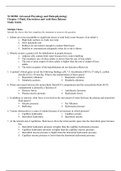Exam (elaborations)
NURS501 Advanced Physiology and Pathophysiology Chapter 3 Fluid, Electrolytes and Acid-Base Balance Study Guide
- Course
- NURS 501
- Institution
- University Of Arizona
1. Infants are most susceptible to significant losses in total body water because of an infant’s: a. High body surface–to–body size ratio b. Slow metabolic rate c. Kidneys are not mature enough to counter fluid losses d. Inability to communicate adequately when he or she is thirsty 2. Obesit...
[Show more]



